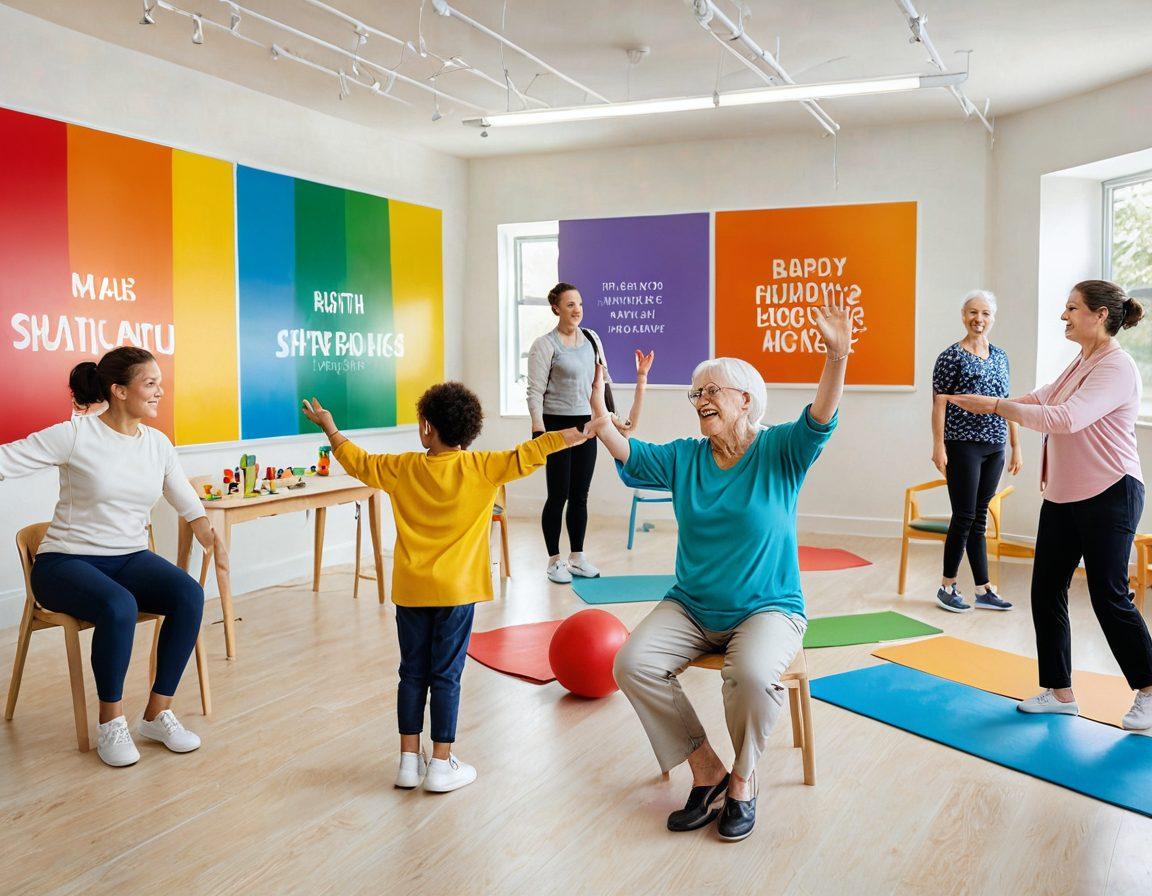Unleashing Joyful Movement: Exploring the Bobath Therapy Approach for Cheerful Rehabilitation
In a world where rehabilitation often feels grim and daunting, the Bobath therapy approach introduces a refreshing burst of joy and vitality. Imagine instead of navigating a sterile clinic, you enter a space filled with laughter, hope, and the rhythm of cheerful movement. The Bobath therapy, fundamentally rooted in neurorehabilitation, seeks not just to treat but to transform the experience of rehabilitation into something uplifting and vibrant. How does a method so focused on joyful movement capture the essence of rehabilitation, you might ask? Let’s dive into the colorful world of Bobath treatment and discover the power it holds in revitalizing both body and spirit.
One of the standout features of the Bobath concept is its emphasis on the individuality of each patient. Instead of a one-size-fits-all regimen, this neurodevelopmental approach tailors therapy methods to individual needs, creating a more personal and engaging experience. For instance, in pediatric therapy, the therapeutic exercises are deliberately designed to tap into a child's innate curiosity and playfulness. Have you ever seen a child practice walking while chasing after a bright, bouncing ball? That’s the beauty of blending movement therapy with joy! It transforms ordinary rehab techniques into a fun-filled journey of growth and progress.
Furthermore, the application of Bobath therapy extends far beyond children. Adults recovering from conditions such as stroke often find traditional rehabilitation intimidating. However, when Bobath principles guide post-stroke therapy sessions, they uncover a pathway to functional recovery that integrates joyful movement. The idea isn't just to rebuild motor skills but to revitalize one's spirit. Picture this: a therapy session where laughter and camaraderie replace the usual silence. Participants share their triumphs, no matter how small, igniting a collective motivation to push forward. Isn't that uplifting? Such an environment can play a crucial role in enhancing rehabilitation outcomes and promoting a sense of community among patients.
Have you ever encountered a barrier in your journey to recovery? Many individuals face emotional hurdles that can stall their progress. The Bobath therapy approach acknowledges such struggles, emphasizing a supportive atmosphere that nurtures both mental and physical well-being. By encouraging patients to express themselves and engage in movement freely, it fosters resilience and enhances personal empowerment. It's not just about physical therapy; it cherishes the concept of joyful living, providing individuals with the tools they need to conquer life's challenges head-on. What if joyful movement could become a daily practice, not only within therapy but in life?
In conclusion, the journey to recovery—whether it's through stroke rehabilitation or child rehabilitation—can be infused with cheer and positivity through the Bobath therapy approach. With a focus on functional recovery, motor skills therapy, and joyful movement, this method can transform the daunting landscape of rehab into a colorful tapestry of opportunities. So, as you explore therapeutic options, remember the power of joy that Bobath brings. What steps can you take today to incorporate that joyful movement into your life or the life of someone you love? Let's embrace the transformation together and celebrate each step towards recovery!
Unlocking Potential: How the Bobath Approach Transforms Movement for All Ages
Have you ever watched a child take their first steps, eyes wide with excitement, pure joy radiating from every movement? Or seen someone recovering from a stroke, rediscovering the simple pleasure of walking, of moving? Joyful moments such as these are foundational in the Bobath therapy approach, a revolutionary method that invites people of all ages to unlock their movement potential. The Bobath concept stands out as a beacon of hope in neurorehabilitation, transforming not just how we perceive therapy, but also how we experience our bodies and lives through movement.
At the heart of the Bobath therapy approach lies the understanding that movement is more than a physical act; it's a vital component of our identity. Think about it: how often do we take our mobility for granted? For many, especially those navigating challenges like pediatric therapy in children or post-stroke therapy for adults, movement can be a significant hurdle. Yet, the Bobath treatment empowers individuals to reclaim their functional abilities in a way that feels natural and joyful, unlocking the potential that lies dormant within us all.
Many of us might wonder, 'How does the Bobath concept really work?' Well, in a nutshell, it relies on a keen understanding of neurodevelopmental approach principles, focusing on facilitating normal movement patterns while addressing the individual's specific needs. The gentle, nurturing nature of the techniques utilized in the Bobath approach ensures that therapy feels less like a chore and more like sharing moments of joy. Imagine a child using play to enhance their motor skills or an adult discovering new pleasures in movement during stroke rehabilitation. These scenarios exemplify how therapy methods can ignite a spark of cheerful creativity in rehabilitation.
Engaging in movement therapy through the Bobath approach does not only foster physical recovery; it nurtures emotional health too. As individuals progressively gain confidence in their mobility—whether through therapeutic exercises designed for child rehabilitation or tailored rehab techniques for adults—there's an undeniable sense of joy that bubbles over. Movement becomes a means of expression and a channel of connection, transforming the often daunting journey of rehabilitation into a colorful adventure of rediscovery.
Ultimately, the Bobath therapy approach shows us that recovery does not have to be a rigid path; it's an evolving journey full of potential. When we embrace the notion of joyful rehabilitation, we open doors to functional recovery that feels uplifting rather than restrictive. So, whether you're engaging in pediatric therapy, overcoming the hurdles of stroke rehabilitation, or simply wishing to enhance your quality of life, remember that every movement is a step towards joy. After all, aren't we all just looking for a little more cheerfulness in our lives?
From Stroke Recovery to Child Development: The Joyful Impact of Bobath Therapy
Imagine the sound of laughter echoing through a therapy room, the kind of joyful noise that inspires hope and encouragement. This is the essence of the Bobath Therapy Approach, a method used in rehabilitation that transforms not just movements, but lives. From stroke recovery to child development, the Bobath Concept embodies a cheerful philosophy that promotes functional recovery through movement. Have you ever considered how joyful movement can rebuild not just the body, but the spirit?
Bobath Therapy has established itself as a powerful ally in the world of neurorehabilitation, acting as a beacon of hope for stroke survivors and children with developmental challenges alike. This neurodevelopmental approach emphasizes the importance of embracing movement through therapeutic exercises that cater to individual needs. With its focus on enhancing motor skills and functional independence, Bobath treatment has evolved into a thoughtful blend of play and purpose, leading to significant progress in rehabilitation. As social workers and therapists often say, 'To move is to heal.' How do you perceive the role of movement in your own therapeutic journeys?
At the heart of Bobath Therapy lies its emphasis on the joy of movement, something that resonates deeply in both pediatric therapy and post-stroke therapy. Just imagine a child who struggles to walk, finding that simple act transformed into a game of exploration and adventure. Similarly, consider the adult patient who has lost their independence after a stroke, gradually regaining the ability to perform daily tasks through engaging rehab techniques. Both scenarios showcase how joyful, playful patterns of movement can foster a positive environment for progress, pushing barriers and producing outcomes that are as remarkable as they are rewarding.
In a world filled with therapeutic methods, what sets the Bobath approach apart is its holistic focus on relationships and the interactions between practitioners, patients, and their environment. It's about creating a cheerful experience, one where patients feel supported, engaged, and eager to participate in their rehab journey. This is not just about physical therapy; it’s about a mindset that values connection and progress. Can you recall a moment in your life where connection propelled you forward? What if that same connection could help someone rediscover their potential?
Ultimately, the joyful impact of the Bobath Therapy Approach lies in its ability to inspire hope and rebuild lives. Whether through the laughter of children mastering motor skills therapy or the determined spirit of adults reclaiming their autonomy, the essence of Bobath therapy resonates with the potential for recovery and growth. So, what role can you embrace in sharing this joyful narrative? How might you advocate for the incredible possibilities offered by this versatile therapy method? The journey of healing through movement awaits - let’s explore, understand, and celebrate it together!


